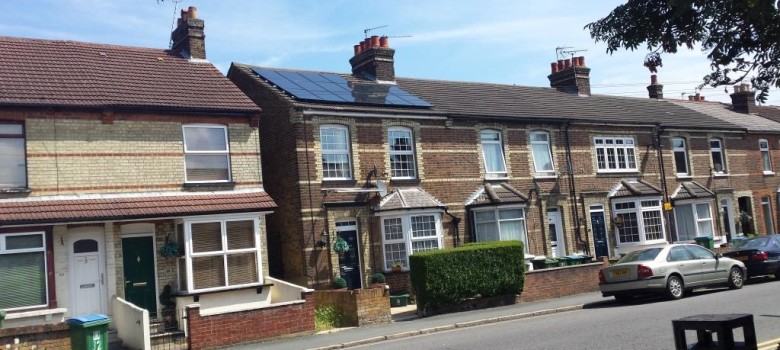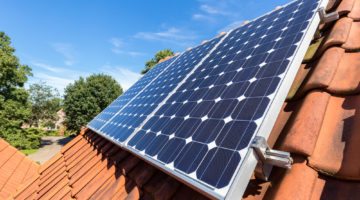
UPDATE: The Feed-In Tariff is now closed for new applications. To find out about the new scheme designed to replace it, click here.
Solar PV is already hugely popular here in the UK with over 600,000 households benefiting from solar panels installed on their roofs. You might think that solar PV is made for ‘Greenies’ who dream of living off grid, but actually solar panels can provide a nice regular tax-free income too!
Under the Government’s Feed-in tariff, the homeowner is paid for every unit of electricity that is produced from the solar panels. It doesn’t matter if the electricity is used in the home or sold back to the grid – you get paid for each unit produced – guaranteeing you a return tax-free return on your investment for 20 years (the current length of the Feed-in tariff).
So why is now such a good time to install solar panels on your roof?
Well firstly the cost of the getting a solar system put on your roof is at a record low. A 4kW system that could provide you with £1,000 + per year (through energy savings and the Feed-in tariff) can cost as little as £5,000 – £6,000. That means a payback of just 5-6 years.
Another reason for going for solar now is that the feed in tariff gets reviewed every 3 months, at which point the Government can make the call whether to reduce the payments. Whatever the feed-in tariff rate is when you register your solar system will be the payment you will receive for the next 20 years. You lock in your payment – so doing it now will ensure you get a decent feed-in tariff rate which will therefore reduce the payback of the solar PV system.

A couple of things to make sure when choosing your solar installer
The installers HAVE to be MCS registered – otherwise you won’t be able to access the feed-in tariff. Obviously you will still benefit from the free electricity you are producing, but it makes sense to get paid for the electricity you produce if someone is willing to do it!
Secondly a south facing roof will produce the most electricity just because of the orientation of the sun during the day. If a solar installer tries to tell you that your north facing roof is going to provide you with a huge return if you put solar panels on it, take this with a rather large pinch of salt!
Obviously we are now at the beginning of the summer, so by installing your solar panels now you will not only lock in to the higher Feed-in tariff rate (12.92p / kWh between 1st July 2015 and 30 September 2015) you will also produce a decent amount of electricity before the colder weather sets in. It is worth mentioning that solar panels don’t produce nearly as much electricity during the winter months than they do during the summer, so don’t be surprised when your quarterly feed-in tariff payments go down for the two winter quarters.
Remember the feed-in tariff is only ever going to go down as time moves forward (there were some people lucky enough to lock in a rate of 43p / kWh during 2011. So if you want to maximise your tax-free return from solar panels we suggest moving relatively quickly. The installation process itself will take just a day or two, but with all large investments we do suggest getting a couple of quotes and doing a bit of research into the install company to check they are a reputable company.
If you would like to get a quote from one of our solar PV installers across the country click on the link below – all our installer network are MCS certified so you will be able to benefit from the Government’s Feed-in tariff.
Installing Solar PV
Are you thinking about installing a solar PV system at home? We have scoured the country for the best tradespeople, so that we can make sure we only recommend those we really trust.
If you would like us to find you a local installer to help install a solar PV system in your home, just fill in the form below and we will be in touch shortly!












That’s all very well and good (despite the usual inbuilt cost discrimination to heavily-taxed lower-middle income earners in installation and reducing feedback tariff) -but it remains a fact that, with domestic mains electric storage still in its infancy and likely to be prohibitively expensive for some time even when it does arrive for early (rich) adopters , solar pv is really only of use to householders who are during much of the day at peak generation to use that solar power ‘live’ at low cost. Solar thermal (which can usefully be stored in a hw cylinder) remains a better financial and practical better in many ways.
Hi Rar,
Thanks for your comment – I have to disagree though purely based on the Government incentives. So you are paid the feed-in tariff if you produce electricity from your solar panels regardless of whether you use the electricity or not – you are simply paid for generating it, hence even if you don’t use it you still benefit from an economical point of view. The other thing is there are now solar diverters that can take any excess electricity and send it through to the immersion unit on the hot water tank so while Solar PV can produce hot water and electricity, solar thermal panels can only produce hot water.
So we have a SW facing roof in Northern Scotland. We can just about have a 4kw pv array on the roof. there is two of us living in our detached house with cavity wall insulation, double glazing, and we are thinking of an air source heat pump with wet radiators for space and water heating. 2 bedrooms and a box room and a large lounge and kitchen/dinner downstairs. We are both out at work through the day. I have been advised to have thermal instead of PV and also to have say a 3kw PV array and two solar thermal panels on the roof. Any advice would be very welcome